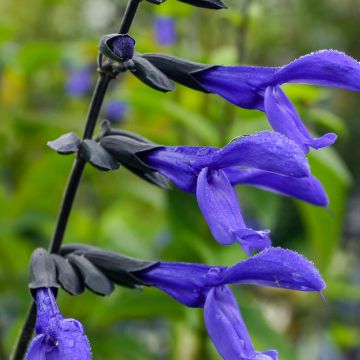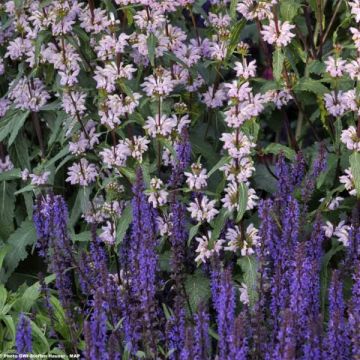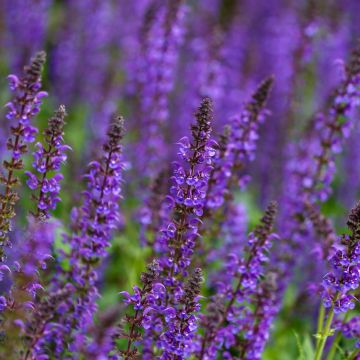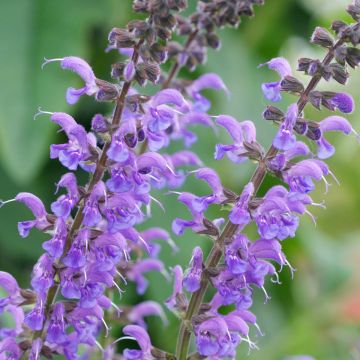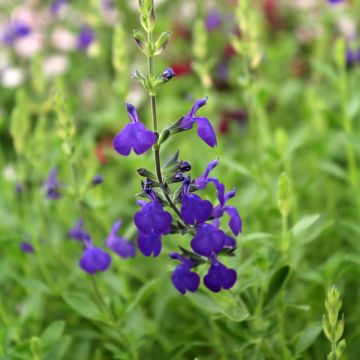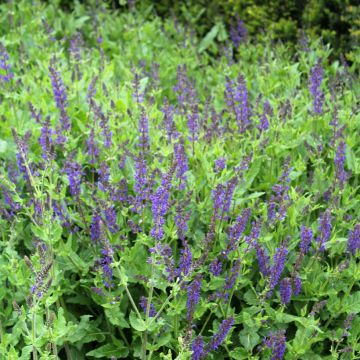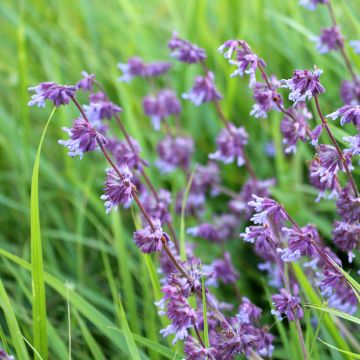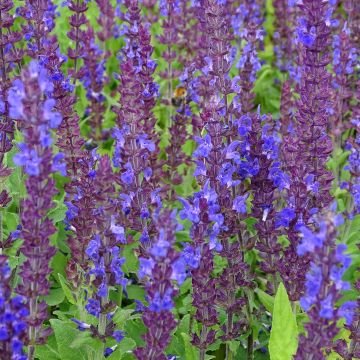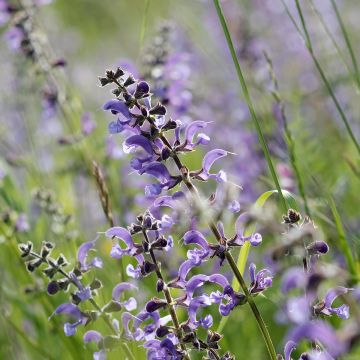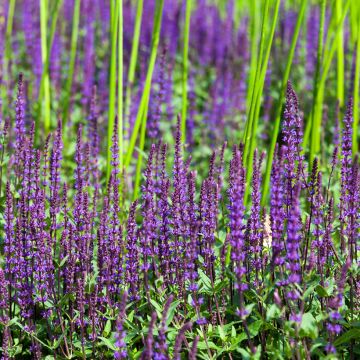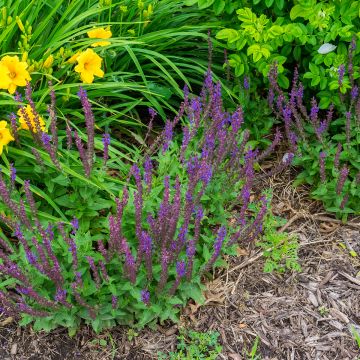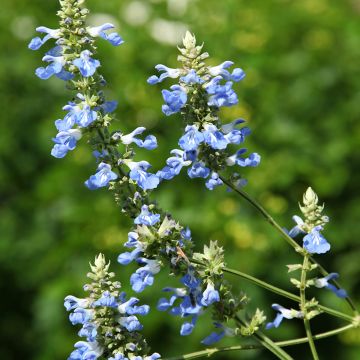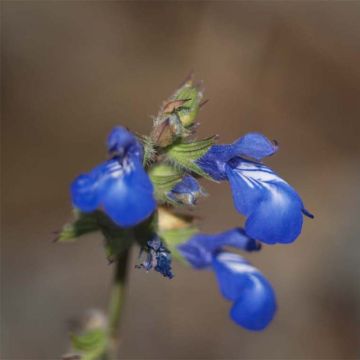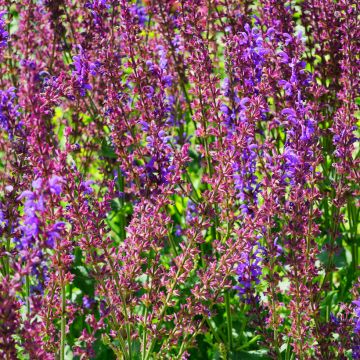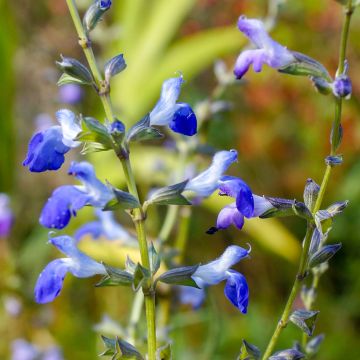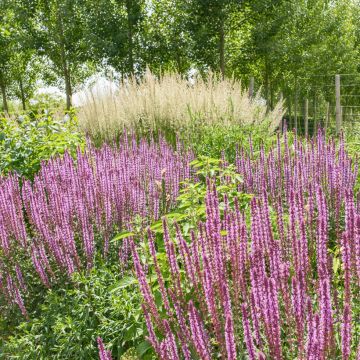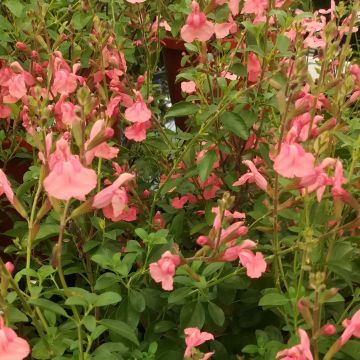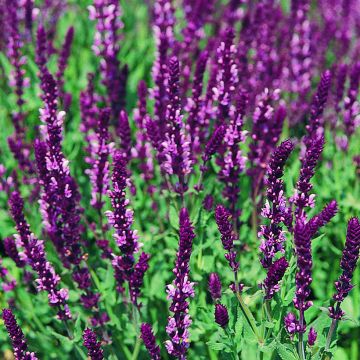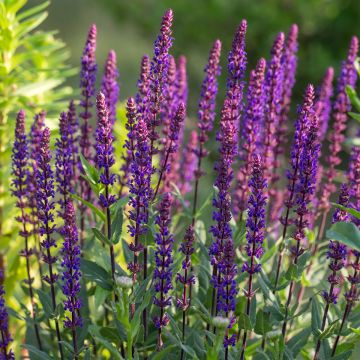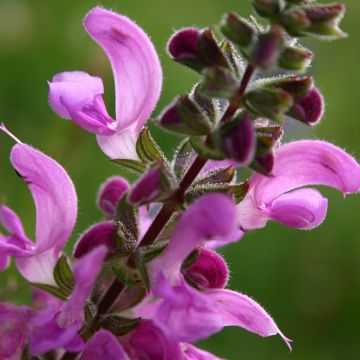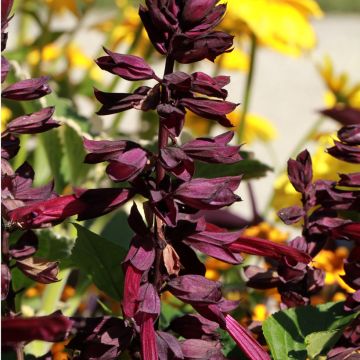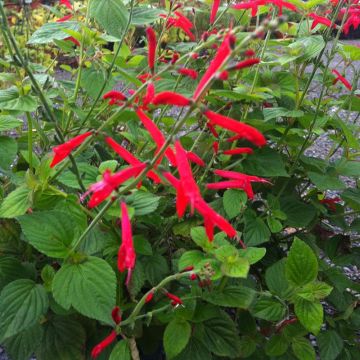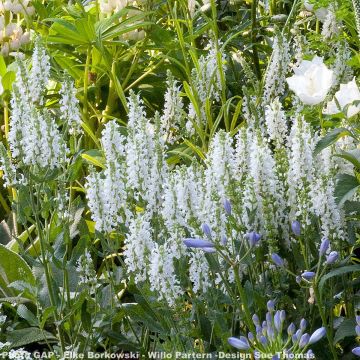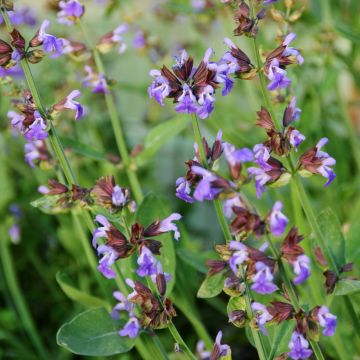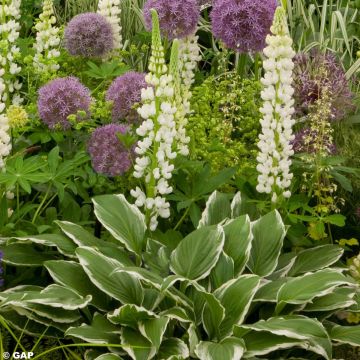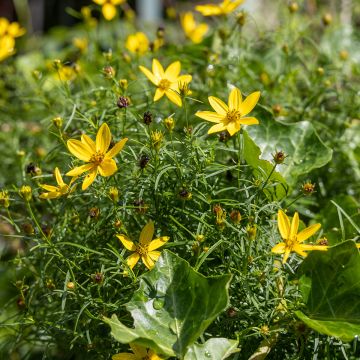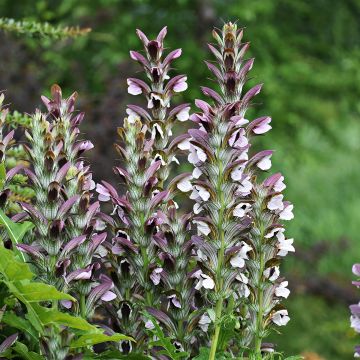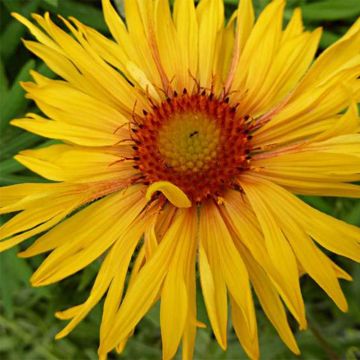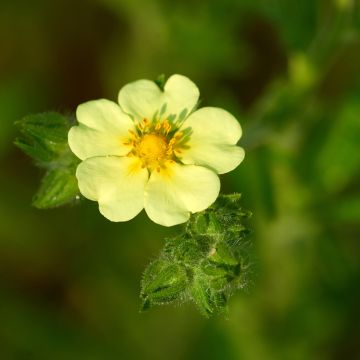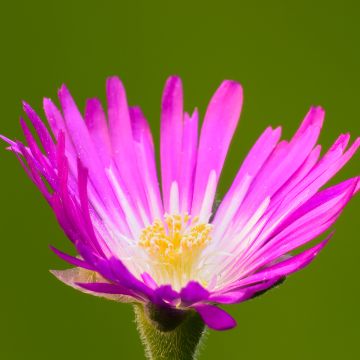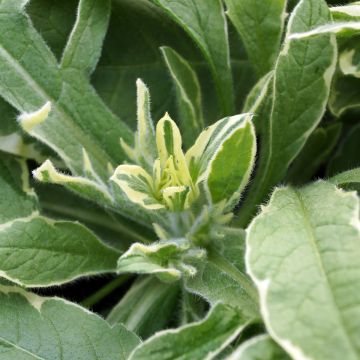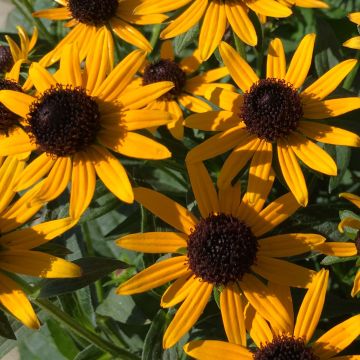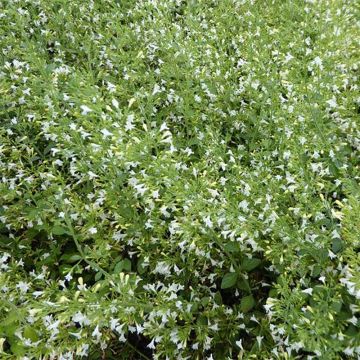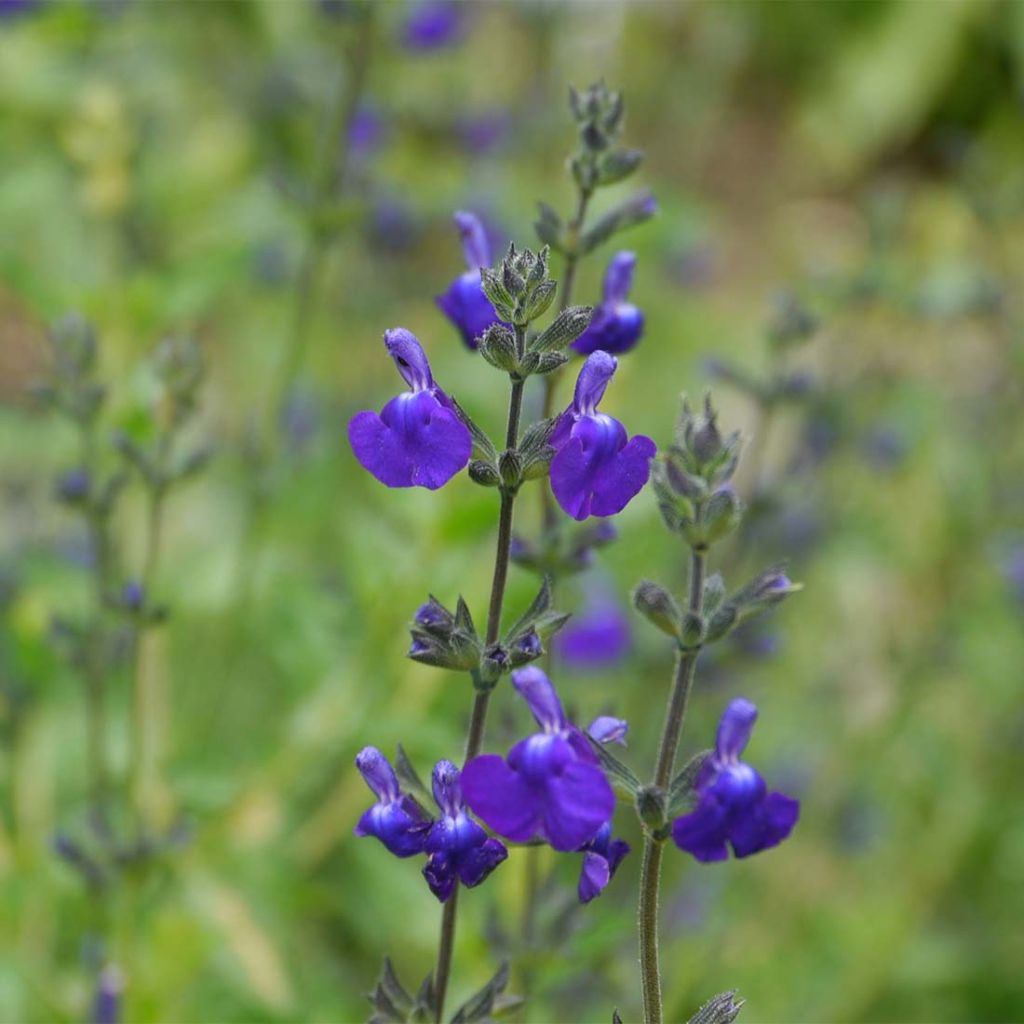

Salvia Victoria Blue
Salvia Victoria Blue
Salvia x microphylla Victoria Blue® 'Vivisal'
Sage
Why not try an alternative variety in stock?
View all →This plant carries a 12 months recovery warranty
More information
We guarantee the quality of our plants for a full growing cycle, and will replace at our expense any plant that fails to recover under normal climatic and planting conditions.
From €5.90 for pickup delivery and €6.90 for home delivery
Express home delivery from €8.90.
Delivery to Corse prohibited: UE law prohibits the import of this plant from mainland France to Corse as part of the fight against Xylella fastidiosa. Please accept our sincere apologies.
More information

Does this plant fit my garden?
Set up your Plantfit profile →
Description
Salvia 'Victoria Blue' is a superb selection of shrubby sage recently obtained in France. This variety surprises with the colour of its small flowers, a deep violet-blue of rare intensity. They bloom almost continuously from June to September, provided that the plant receives some watering during dry periods. Unlike the majority of blue-flowered cultivars, 'Victoria Blue' has a rather upright habit and forms a dense and well-groomed clump, excellent for borders but also in containers. Microphylla-type salvias are drought-tolerant, remarkably floriferous, and robust but only moderately hardy. In the garden or on the terrace, combine Victoria Blue with varieties with fuchsia pink or velvet red flowers, purple or silver foliage, the result is sumptuous, to say the least!
'Victoria Blue' was recently obtained in France by Christian VIVIES from Salvia microphylla grahamii, among others. This botanical species, also known as Graham's Sage, is a woody perennial plant of the Lamiaceae family native to the Mexican mountains and southern Arizona.
Salvia 'Victoria Blue' has a slightly upright bushy habit, taller than wide. It will quickly reach about 60 cm (24in) in height and 50 cm (20in) in diameter, within 2 to 3 years. The nectar-rich flowering is generous from late spring to late summer until cold weather puts an end to it. The small elongated flowers borne on very dark stems, in 20 cm (8in) spikes rise above the foliage. They measure 2 cm (1in) in length and are a captivating deep violet-blue shade, illuminated by a small sky blue to white centre and enhanced by small bracts tinged with midnight blue and purple. They only last for a day, covering the ground with their petals in the evening, but will already be replaced the next morning. The semi-evergreen foliage is composed of small ovate leaves with wavy edges, 3 cm (1in) long, dark green, thick, and aromatic, slightly sticky, releasing a strongly acidic-smelling essential oil with heat. Sometimes in autumn, they take on pretty yellow and purple hues.
Only hardy down to -10°C (14°F) in well-drained soil, 'Victoria Blue' sage is nevertheless robust and spectacular; it grows quickly and floods borders or terraces with its long-lasting intense blue flowering. It only requires very well-drained soil, even poor, in sunny or semi-shaded exposure. The lower autumn light enhances the flowering of shrubby salvias, which capture light through their petals like tiny stained glass windows. 'Victoria Blue' lightens up all spring or summer bloomings. But its association with pink autumn asters, 'Royal Bumble' salvias, or the wild species S. grahamii with intense fuchsia flowers is truly fabulous. California poppies, orange tritomas, tall sedums, red foliage of Loropetalum or silver artemisias, sea cinerarias, and certain euphorbias (Euphorbia Ponte Leccia) will compose a charming tableau with it. On the terrace, plant it in a large pot, right next to a Sesbania punicea with outrageously orange pea-like flowers; the colour combination is fantastic!
Report an error about the product description
Salvia Victoria Blue in pictures
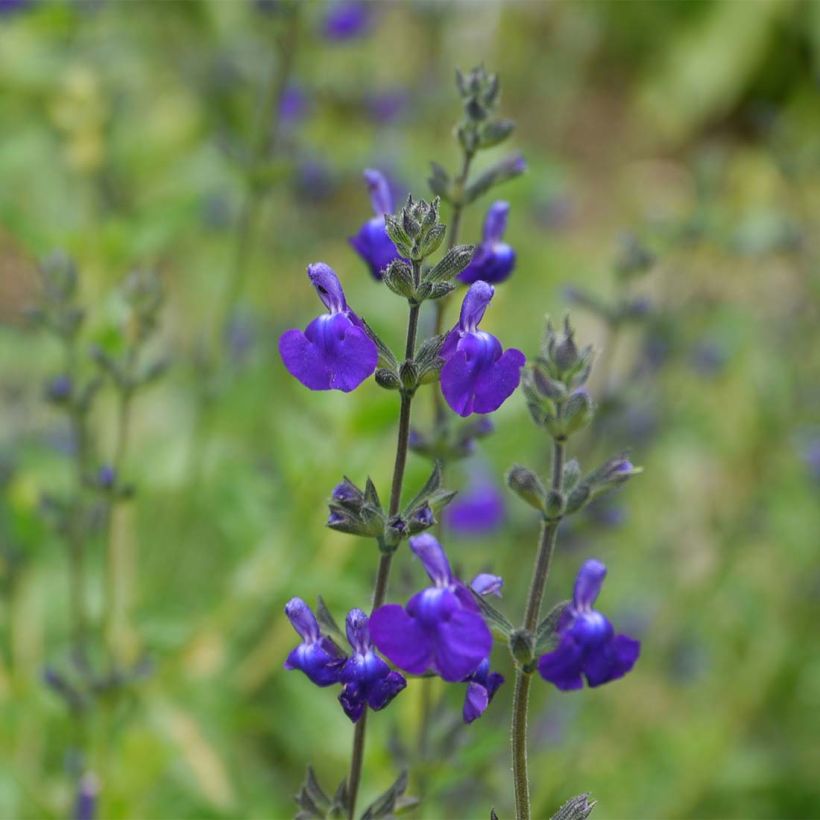

Flowering
Foliage
Plant habit
Botanical data
Salvia
x microphylla
Victoria Blue® 'Vivisal'
Lamiaceae
Sage
Cultivar or hybrid
Other Salvia - Sage
Planting and care
Easy to grow, the Small-leaved Sage can be planted all year round, except during freezing periods. It can withstand temperatures as low as -10°C (14°F) in well-drained soil, in full sun and sheltered from the wind. It can be placed in a sunny exposure or partial shade. It is a plant that thrives in light, moist but well-drained soil. It is also adapted to dry soil, so it is better to forget to water rather than overwater. At planting, you can provide it with a base fertilizer. Place mulch at the base of the plant as the cold weather approaches, or cover it with fleece. Watering is beneficial in summer, during prolonged drought. As for pruning, lightly trim the stems that compromise symmetry and prune to 20 cm (8in) above ground after the last strong spring frosts (in March-April depending on the region). Remove faded flowers when possible.
Planting period
Intended location
Care
-
, onOrder confirmed
Reply from on Promesse de fleurs
Summer flowering perennials
Haven't found what you were looking for?
Hardiness is the lowest winter temperature a plant can endure without suffering serious damage or even dying. However, hardiness is affected by location (a sheltered area, such as a patio), protection (winter cover) and soil type (hardiness is improved by well-drained soil).

Photo Sharing Terms & Conditions
In order to encourage gardeners to interact and share their experiences, Promesse de fleurs offers various media enabling content to be uploaded onto its Site - in particular via the ‘Photo sharing’ module.
The User agrees to refrain from:
- Posting any content that is illegal, prejudicial, insulting, racist, inciteful to hatred, revisionist, contrary to public decency, that infringes on privacy or on the privacy rights of third parties, in particular the publicity rights of persons and goods, intellectual property rights, or the right to privacy.
- Submitting content on behalf of a third party;
- Impersonate the identity of a third party and/or publish any personal information about a third party;
In general, the User undertakes to refrain from any unethical behaviour.
All Content (in particular text, comments, files, images, photos, videos, creative works, etc.), which may be subject to property or intellectual property rights, image or other private rights, shall remain the property of the User, subject to the limited rights granted by the terms of the licence granted by Promesse de fleurs as stated below. Users are at liberty to publish or not to publish such Content on the Site, notably via the ‘Photo Sharing’ facility, and accept that this Content shall be made public and freely accessible, notably on the Internet.
Users further acknowledge, undertake to have ,and guarantee that they hold all necessary rights and permissions to publish such material on the Site, in particular with regard to the legislation in force pertaining to any privacy, property, intellectual property, image, or contractual rights, or rights of any other nature. By publishing such Content on the Site, Users acknowledge accepting full liability as publishers of the Content within the meaning of the law, and grant Promesse de fleurs, free of charge, an inclusive, worldwide licence for the said Content for the entire duration of its publication, including all reproduction, representation, up/downloading, displaying, performing, transmission, and storage rights.
Users also grant permission for their name to be linked to the Content and accept that this link may not always be made available.
By engaging in posting material, Users consent to their Content becoming automatically accessible on the Internet, in particular on other sites and/or blogs and/or web pages of the Promesse de fleurs site, including in particular social pages and the Promesse de fleurs catalogue.
Users may secure the removal of entrusted content free of charge by issuing a simple request via our contact form.
The flowering period indicated on our website applies to countries and regions located in USDA zone 8 (France, the United Kingdom, Ireland, the Netherlands, etc.)
It will vary according to where you live:
- In zones 9 to 10 (Italy, Spain, Greece, etc.), flowering will occur about 2 to 4 weeks earlier.
- In zones 6 to 7 (Germany, Poland, Slovenia, and lower mountainous regions), flowering will be delayed by 2 to 3 weeks.
- In zone 5 (Central Europe, Scandinavia), blooming will be delayed by 3 to 5 weeks.
In temperate climates, pruning of spring-flowering shrubs (forsythia, spireas, etc.) should be done just after flowering.
Pruning of summer-flowering shrubs (Indian Lilac, Perovskia, etc.) can be done in winter or spring.
In cold regions as well as with frost-sensitive plants, avoid pruning too early when severe frosts may still occur.
The planting period indicated on our website applies to countries and regions located in USDA zone 8 (France, United Kingdom, Ireland, Netherlands).
It will vary according to where you live:
- In Mediterranean zones (Marseille, Madrid, Milan, etc.), autumn and winter are the best planting periods.
- In continental zones (Strasbourg, Munich, Vienna, etc.), delay planting by 2 to 3 weeks in spring and bring it forward by 2 to 4 weeks in autumn.
- In mountainous regions (the Alps, Pyrenees, Carpathians, etc.), it is best to plant in late spring (May-June) or late summer (August-September).
The harvesting period indicated on our website applies to countries and regions in USDA zone 8 (France, England, Ireland, the Netherlands).
In colder areas (Scandinavia, Poland, Austria...) fruit and vegetable harvests are likely to be delayed by 3-4 weeks.
In warmer areas (Italy, Spain, Greece, etc.), harvesting will probably take place earlier, depending on weather conditions.
The sowing periods indicated on our website apply to countries and regions within USDA Zone 8 (France, UK, Ireland, Netherlands).
In colder areas (Scandinavia, Poland, Austria...), delay any outdoor sowing by 3-4 weeks, or sow under glass.
In warmer climes (Italy, Spain, Greece, etc.), bring outdoor sowing forward by a few weeks.

































